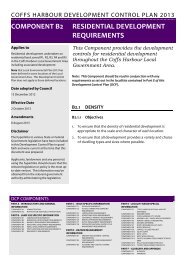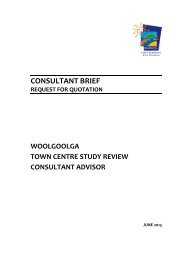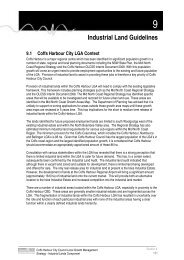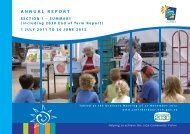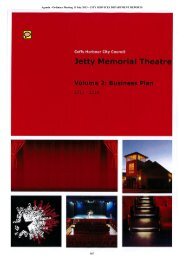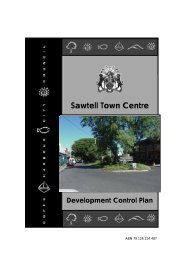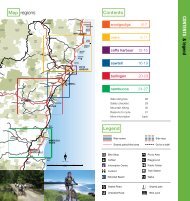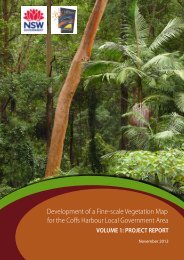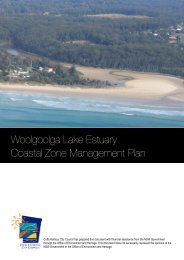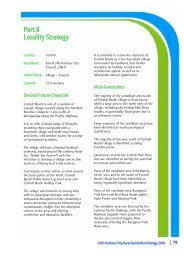- Page 2 and 3: © Copyright State of NSW and the O
- Page 4 and 5: Credits and AcknowledgementsThis pr
- Page 6 and 7: HEATHLANDSCoast Banksia Shrubland O
- Page 10 and 11: assigned to them and the Biometric
- Page 12 and 13: Page 6Vegetation Mapping of the Cof
- Page 14 and 15: CH_RF01Floristic summaryLayer Heigh
- Page 16 and 17: CH_RF01Diagnostic speciesSpecies Na
- Page 18 and 19: CH_RF02Floristic summaryLayer Heigh
- Page 20 and 21: CH_RF02Diagnostic SpeciesSpecies Na
- Page 22 and 23: CH_RF03Floristic summaryLayer Heigh
- Page 24 and 25: CH_RF03Diagnostic speciesSpecies Na
- Page 26 and 27: CH_RF03Species NameGroup score(50 p
- Page 28 and 29: CH_RF04Floristic summaryLayer Heigh
- Page 30 and 31: CH_RF04Species NameGroup score(50 p
- Page 32 and 33: CH_RF05FOOTHILLS BROWN MYRTLE DRY R
- Page 34 and 35: CH_RF05LocationsKnown examples incl
- Page 36 and 37: CH_RF06Floristic summaryLayer Heigh
- Page 38 and 39: CH_RF07COASTAL EXPOSED DUNE LITTORA
- Page 40 and 41: CH_RF07Page 34Vegetation Mapping of
- Page 42 and 43: CH_RF07Species NameGroup score(50 p
- Page 44 and 45: CH_RF08Floristic summaryLayer Heigh
- Page 46 and 47: CH_RF08Diagnostic speciesSpecies Na
- Page 48 and 49: CH_RF08Species NameGroup score(50 p
- Page 50 and 51: CH_RF09Floristic summaryLayer Heigh
- Page 52 and 53: CH_RF09Diagnostic speciesSpecies Na
- Page 54 and 55: CH_RF11ESCARPMENT AND LOWLAND BANGA
- Page 56 and 57: CH_RF11EquivalentsBiometric: Black
- Page 58 and 59:
CH_RF11Diagnostic speciesSpecies Na
- Page 60 and 61:
CH_RF11Species NameGroup score(50 p
- Page 62 and 63:
CH_RF11Species NameGroup score(50 p
- Page 64 and 65:
CH_RF12Floristic summaryLayer Heigh
- Page 66 and 67:
CH_RF12Diagnostic speciesSpecies Na
- Page 68 and 69:
CH_RF12Species NameGroup score(50 p
- Page 70:
CH_RF12Species NameGroup score(50 p
- Page 76 and 77:
CH_RF13Species NameGroup score(50 p
- Page 78 and 79:
Page 72Vegetation Mapping of the Co
- Page 80 and 81:
CH_WSF01Floristic summaryLayer Heig
- Page 82 and 83:
CH_WSF01Page 76Vegetation Mapping o
- Page 84 and 85:
CH_WSF01Species NameGroup score(50
- Page 86 and 87:
CH_WSF01Species NameGroup score(50
- Page 88 and 89:
CH_WSF02Floristic summaryLayer Heig
- Page 90 and 91:
CH_WSF02Page 84Vegetation Mapping o
- Page 92 and 93:
CH_WSF02Species NameGroup score(50
- Page 94 and 95:
CH_WSF03FOOTHILLS AND ESCARPMENT BL
- Page 96 and 97:
CH_WSF03the topographical gradient
- Page 98 and 99:
CH_WSF03Diagnostic speciesSpecies N
- Page 100 and 101:
CH_WSF03Species NameGroup score(50
- Page 102 and 103:
CH_WSF05FOOTHILLS TO ESCARPMENT BRU
- Page 104 and 105:
CH_WSF05but Brush Box (Lophostemon
- Page 106 and 107:
CH_WSF05Diagnostic speciesSpecies N
- Page 108 and 109:
CH_WSF05Species NameGroup score(50
- Page 110 and 111:
CH_WSF05Species NameGroup score(50
- Page 112 and 113:
CH_WSF06PLATEAU BLUE GUM - TALLOWWO
- Page 114 and 115:
CH_WSF06Page 108Vegetation Mapping
- Page 116 and 117:
CH_WSF06Diagnostic speciesSpecies N
- Page 118 and 119:
CH_WSF06Species NameGroup score(50
- Page 120 and 121:
CH_WSF07Floristic summaryLayer Heig
- Page 122 and 123:
CH_WSF07Page 116Vegetation Mapping
- Page 124 and 125:
CH_WSF07Species NameGroup score(50
- Page 126 and 127:
CH_WSF08SOUTHERN FOOTHILLS BLACKBUT
- Page 128 and 129:
CH_WSF08LocationsKnown at Bongil Bo
- Page 130 and 131:
CH_WSF08Species NameGroup score(50
- Page 132 and 133:
CH_WSF08Species NameGroup score(50
- Page 134 and 135:
CH_WSF09NORTHERN ESCARPMENT BLACKBU
- Page 136 and 137:
CH_WSF09Relationship to other commu
- Page 138 and 139:
CH_WSF09Diagnostic speciesSpecies N
- Page 140 and 141:
CH_WSF09Species NameGroup score(50
- Page 142 and 143:
CH_WSF10HINTERLAND AND ESCARPMENT T
- Page 144 and 145:
CH_WSF10EquivalentsBiometric: Black
- Page 146 and 147:
CH_WSF10Species NameGroup score(50
- Page 148 and 149:
CH_WSF11FOOTHILLS SPOTTED GUM - MAH
- Page 150 and 151:
CH_WSF11Page 144Vegetation Mapping
- Page 152 and 153:
CH_WSF11Species NameGroup score(50
- Page 154 and 155:
CH_WSF12Floristic summaryLayer Heig
- Page 156 and 157:
CH_WSF12Diagnostic speciesSpecies N
- Page 158 and 159:
CH_WSF13Floristic summaryLayer Heig
- Page 160 and 161:
CH_WSF13Diagnostic speciesSpecies N
- Page 162 and 163:
CH_WSF14Floristic summaryLayer Heig
- Page 164 and 165:
CH_WSF14Diagnostic speciesSpecies N
- Page 166 and 167:
CH_WSF15Floristic summaryLayer Heig
- Page 168 and 169:
CH_WSF15Diagnostic speciesSpecies N
- Page 170 and 171:
CH_WSF15Species NameGroup score(50
- Page 172 and 173:
CH_WSF16Floristic summaryLayer Heig
- Page 174 and 175:
CH_WSF17FOOTHILLS TURPENTINE - GREY
- Page 176 and 177:
CH_WSF17Tree Heath (Trochocarpa lau
- Page 178 and 179:
CH_WSF17Species NameGroup score(50
- Page 180 and 181:
CH_WSF17Species NameGroup score(50
- Page 182 and 183:
CH_WSF18ESCARPMENT NEW ENGLAND BLAC
- Page 184 and 185:
CH_WSF18LocationsKnown examples of
- Page 186 and 187:
CH_WSF18Species NameGroup score(50
- Page 188 and 189:
CH_G01STRANDLINE GRASSLANDSCIENTIFI
- Page 190 and 191:
CH_G01Diagnostic speciesSpecies Nam
- Page 192 and 193:
CH_G02Floristic summaryLayer Height
- Page 194 and 195:
Page 188Vegetation Mapping of the C
- Page 196 and 197:
CH_DOF01This community is very wide
- Page 198 and 199:
CH_DOF01Page 192Vegetation Mapping
- Page 200 and 201:
CH_DOF01Species NameGroup score(50
- Page 202 and 203:
CH_DOF02SANDSTONE BLOODWOOD -NEEDLE
- Page 204 and 205:
CH_DOF02Conservation statusThis com
- Page 206 and 207:
CH_DOF02Diagnostic speciesSpecies N
- Page 208 and 209:
CH_DOF02Species NameGroup score(50
- Page 210 and 211:
CH_DOF04HINTERLAND NEEDLEBARK STRIN
- Page 212 and 213:
CH_DOF04Page 206Vegetation Mapping
- Page 214 and 215:
CH_DOF05FOOTHILLS GREY GUM-IRONBARK
- Page 216 and 217:
CH_DOF05Page 210Vegetation Mapping
- Page 218 and 219:
CH_DOF05Species NameGroup score(50
- Page 220 and 221:
CH_DOF05Species NameGroup score(50
- Page 222 and 223:
CH_DOF06LOWLANDS SWAMP BOX - PAPERB
- Page 224 and 225:
CH_DOF06EquivalentsBiometric: (NR16
- Page 226 and 227:
CH_DOF06Species NameGroup score(50
- Page 228 and 229:
CH_DOF07ESCARPMENT NEW ENGLAND BLAC
- Page 230 and 231:
CH_DOF07Page 224Vegetation Mapping
- Page 232 and 233:
CH_DOF08Floristic summaryLayer Heig
- Page 234 and 235:
CH_DOF08Diagnostic speciesSpecies N
- Page 236 and 237:
CH_DOF09COAST SAND BLACKBUTT - BLOO
- Page 238 and 239:
CH_DOF09LocationsStation Creek area
- Page 240 and 241:
CH_DOF10FOOTHILLS SPOTTED GUM - MAH
- Page 242 and 243:
CH_DOF10EquivalentsBiometric: (NR17
- Page 244 and 245:
CH_DOF10Species NameGroup score(50
- Page 246 and 247:
CH_DOF10Species NameGroup score(50
- Page 248 and 249:
CH_DOF11NORTHERN ESCARPMENT MAHOGAN
- Page 250 and 251:
CH_DOF11Page 244Vegetation Mapping
- Page 252 and 253:
CH_H01COAST BANKSIA SHRUBLAND ON HO
- Page 254 and 255:
CH_H01Relationship to other communi
- Page 256 and 257:
CH_H01Diagnostic speciesSpecies Nam
- Page 258 and 259:
CH_H02COAST WATTLE SHRUBLANDSSCIENT
- Page 260 and 261:
CH_H02Page 254Vegetation Mapping of
- Page 262 and 263:
CH_H03KANGAROO GRASS HEADLAND GRASS
- Page 264 and 265:
CH_H03Page 258Vegetation Mapping of
- Page 266 and 267:
CH_H04COASTAL SHE-OAK - HAKEA CLAY
- Page 268 and 269:
CH_H04Page 262Vegetation Mapping of
- Page 270 and 271:
CH_H05COASTAL DAGGER - HAKEA CLAY H
- Page 272 and 273:
CH_H05Page 266Vegetation Mapping of
- Page 274 and 275:
CH_H05Species NameGroup score(50 pe
- Page 276 and 277:
CH_H06Floristic summaryLayer Height
- Page 278 and 279:
CH_H06Diagnostic speciesSpecies Nam
- Page 280 and 281:
CH_H07COASTAL HEADLAND SWAMP OAK SH
- Page 282 and 283:
CH_H07Page 276Vegetation Mapping of
- Page 284 and 285:
CH_H08WALLUM BANKSIA - BLACK SHE-OA
- Page 286 and 287:
CH_H08Page 280Vegetation Mapping of
- Page 288 and 289:
CH_H09PLATEAU TEA-TREE ROCK OUTCROP
- Page 291 and 292:
CH_H09Diagnostic speciesSpecies Nam
- Page 294 and 295:
CH_H10Page 288Vegetation Mapping of
- Page 296 and 297:
CH_H11Floristic summaryLayer Height
- Page 298 and 299:
CH_H11Diagnostic speciesSpecies Nam
- Page 300 and 301:
CH_FW01COASTAL WALLUM TEA-TREE - BA
- Page 302 and 303:
CH_FW01Page 296Vegetation Mapping o
- Page 304 and 305:
CH_FW02COASTAL WALLUM PAPERBARK - B
- Page 306 and 307:
CH_FW02LocationsMoonee Beach Nature
- Page 308 and 309:
CH_FW02Species NameGroup score(50 p
- Page 310 and 311:
CH_FW03Floristic summaryLayer Heigh
- Page 312 and 313:
CH_FW03Diagnostic speciesSpecies Na
- Page 314 and 315:
CH_FW04Floristic summaryLayer Heigh
- Page 316 and 317:
CH_FW04Diagnostic speciesSpecies Na
- Page 318 and 319:
CH_FW05Floristic summaryLayer Heigh
- Page 320 and 321:
CH_FW05Diagnostic speciesSpecies Na
- Page 322 and 323:
CH_FW06COASTAL WALLUM TEA-TREE TALL
- Page 324 and 325:
CH_FW06Page 318Vegetation Mapping o
- Page 326 and 327:
CH_FW07COASTAL JOINTED TWIG RUSH FR
- Page 328 and 329:
CH_FW07Page 322Vegetation Mapping o
- Page 330 and 331:
CH_FW08COASTAL FRESHWATER WETLANDSC
- Page 332 and 333:
CH_FW08Page 326Vegetation Mapping o
- Page 334 and 335:
CH_FW09COASTAL WALLUM FERNLANDSCIEN
- Page 336 and 337:
CH_FW09Page 330Vegetation Mapping o
- Page 338 and 339:
CH_FrW01COASTAL PAPERBARK - SWAMP O
- Page 340 and 341:
CH_FrW01LocationsBonville, Pine Cre
- Page 342 and 343:
CH_FrW01Species NameGroup score(50
- Page 344 and 345:
CH_FrW02Floristic summaryLayer Heig
- Page 346 and 347:
CH_FrW02Diagnostic speciesSpecies N
- Page 348 and 349:
CH_FrW02Species NameGroup score(50
- Page 350 and 351:
CH_FrW03Floristic summaryLayer Heig
- Page 352 and 353:
CH_FrW03Diagnostic speciesSpecies N
- Page 354 and 355:
CH_FrW04Floristic summaryLayer Heig
- Page 356 and 357:
CH_FrW04Diagnostic speciesSpecies N
- Page 358 and 359:
CH_FrW05Floristic summaryLayer Heig
- Page 360 and 361:
CH_FrW05Species NameGroup score(50
- Page 362 and 363:
CH_FrW06COASTAL WALLUM - SWAMP MAHO
- Page 364 and 365:
CH_FrW06Page 358Vegetation Mapping
- Page 366 and 367:
CH_FrW06Species NameGroup score(50
- Page 368 and 369:
CH_FrW07Floristic summaryLayer Heig
- Page 370 and 371:
CH_FrW07Diagnostic speciesSpecies N
- Page 372 and 373:
CH_FrW08Floristic summaryLayer Heig
- Page 374 and 375:
CH_FrW09COASTAL WALLUM SWAMP MAHOGA
- Page 376 and 377:
CH_FrW09LocationsNorth Bonville; Av
- Page 378 and 379:
CH_FrW09Species NameGroup score(50
- Page 380 and 381:
CH_FrW10Floristic summaryLayer Heig
- Page 382 and 383:
CH_FrW10Diagnostic speciesSpecies N
- Page 384 and 385:
CH_FrW11Floristic summaryLayer Heig
- Page 386 and 387:
CH_FrW11Page 380Vegetation Mapping
- Page 388 and 389:
CH_SW01ESTUARINE MANGROVE FORESTSCI
- Page 390 and 391:
CH_SW01LocationsKnown examples incl
- Page 392 and 393:
CH_SW02Floristic summaryLayer Heigh
- Page 394 and 395:
CH_SW03COASTAL DUNE SEDGELAND SOAKS
- Page 396 and 397:
CH_SW03Page 390Vegetation Mapping o
- Page 398 and 399:
CH_SW04COASTAL DUNE PRICKLY COUCH G
- Page 400 and 401:
CH_SW04Page 394Vegetation Mapping o
- Page 402 and 403:
CH_SW05TWIG RUSH HEADLAND SEDGELAND
- Page 404 and 405:
CH_SW05Page 398Vegetation Mapping o
- Page 406 and 407:
CH_SW06SEA RUSH SALTMARSHSCIENTIFIC
- Page 408 and 409:
CH_SW06Diagnostic speciesSpecies Na
- Page 410 and 411:
CH_SW07Floristic summaryLayer Heigh
- Page 412 and 413:
ReferencesBarkman, JJ 1989, ‘Fide
- Page 414 and 415:
ClassEasternRiverineForestsCoastal
- Page 416 and 417:
ClassMAPCODECH_SW07Short nameEstuar
- Page 418 and 419:
Code Short Name Formation Class Des



